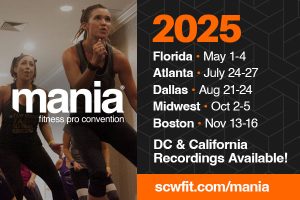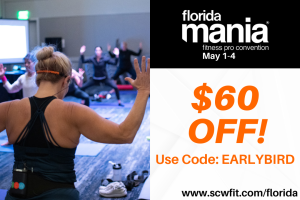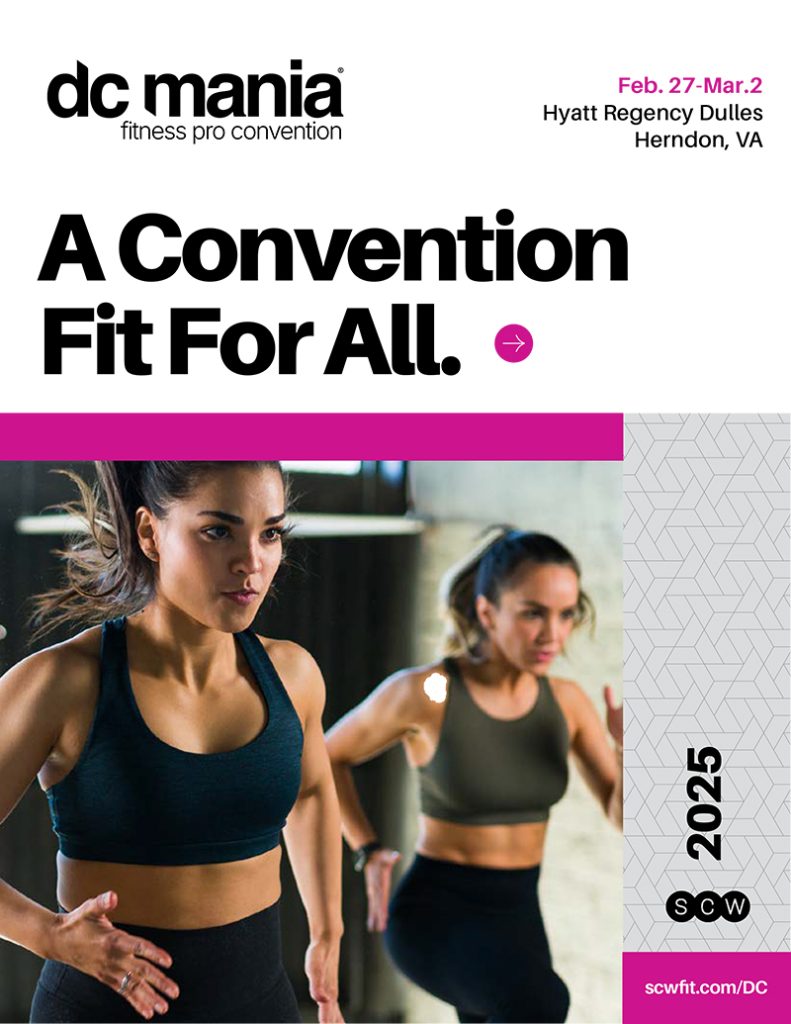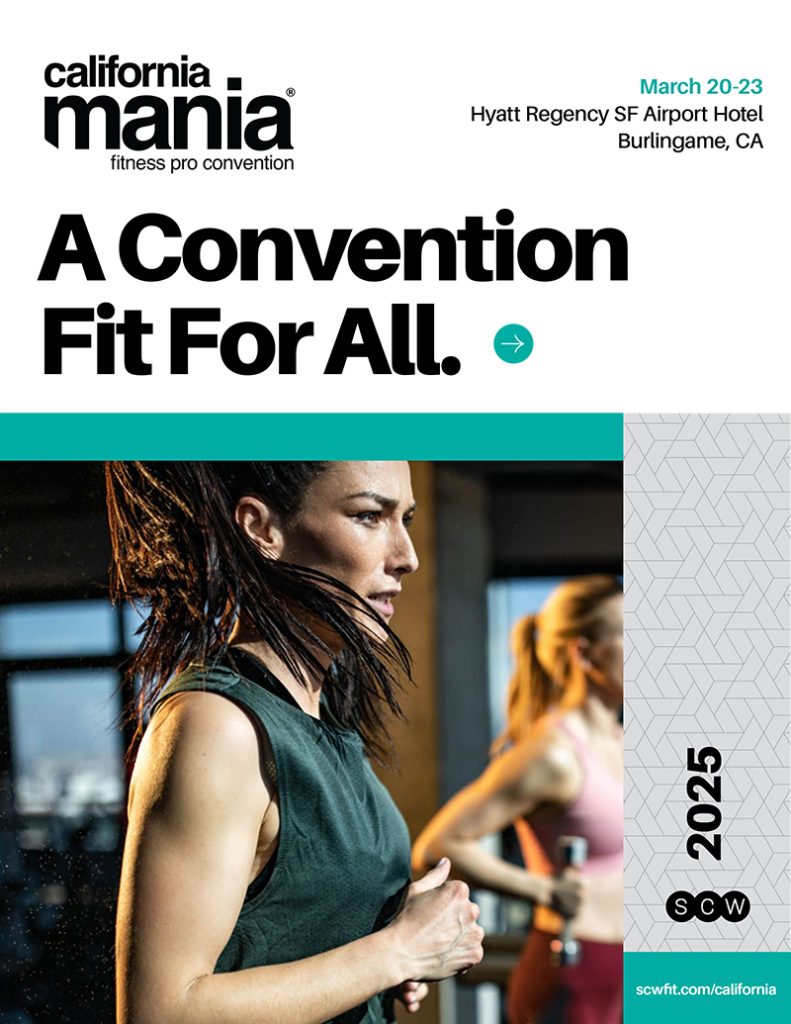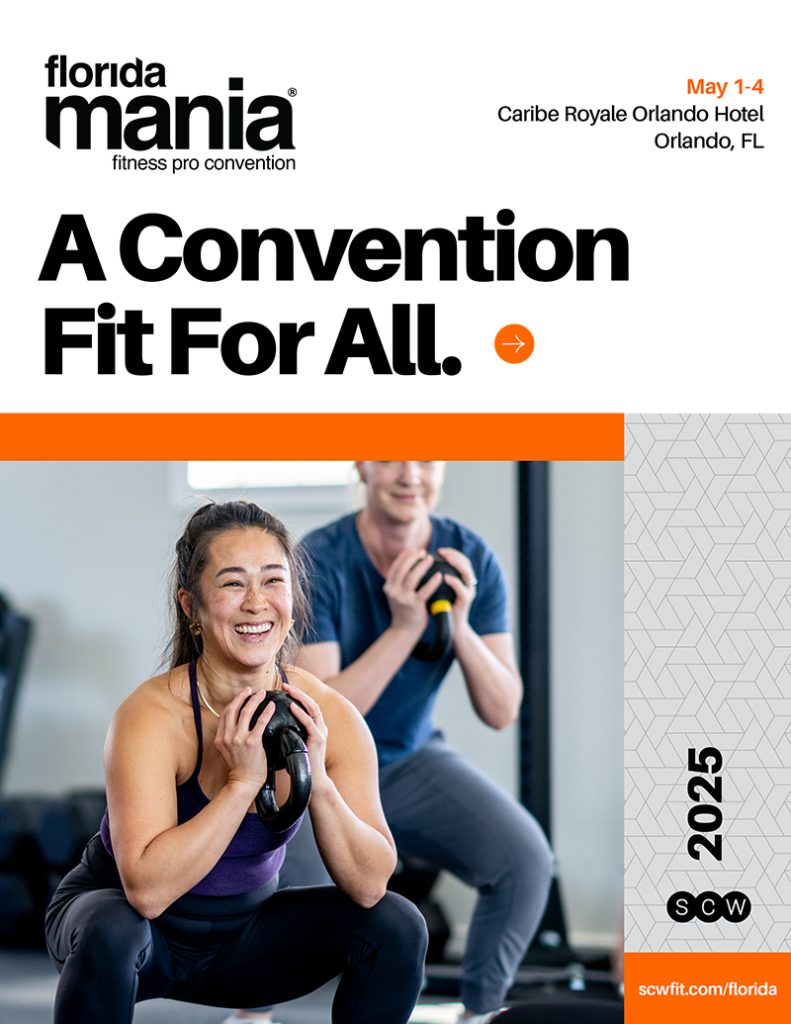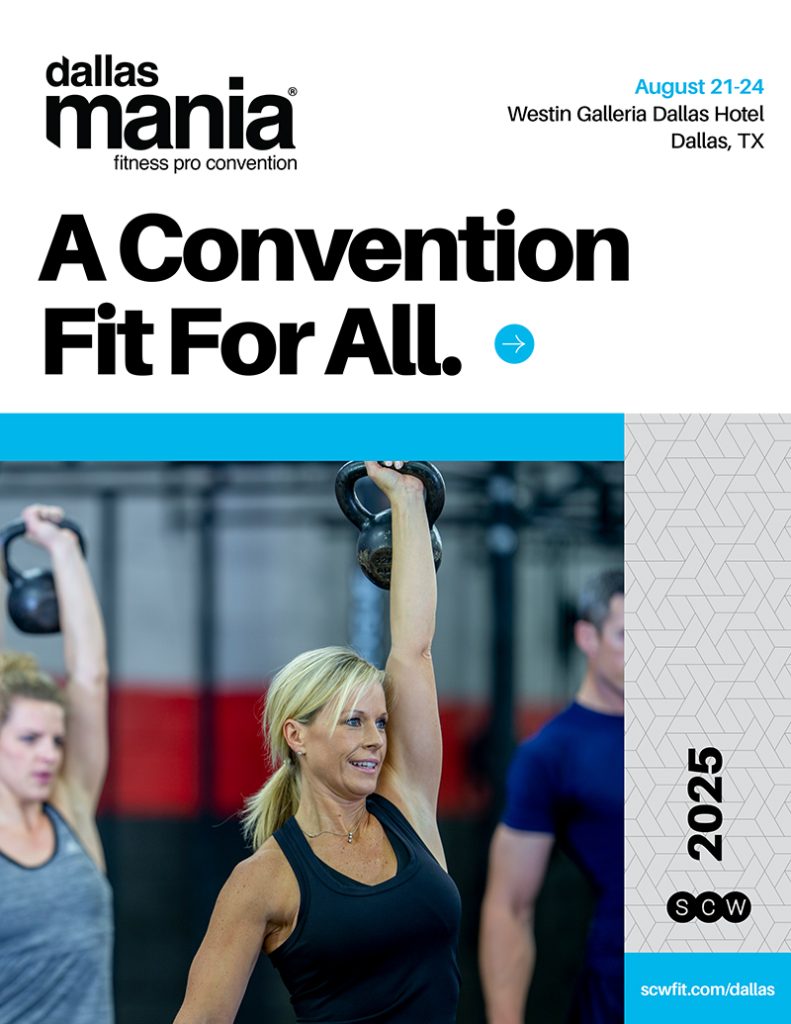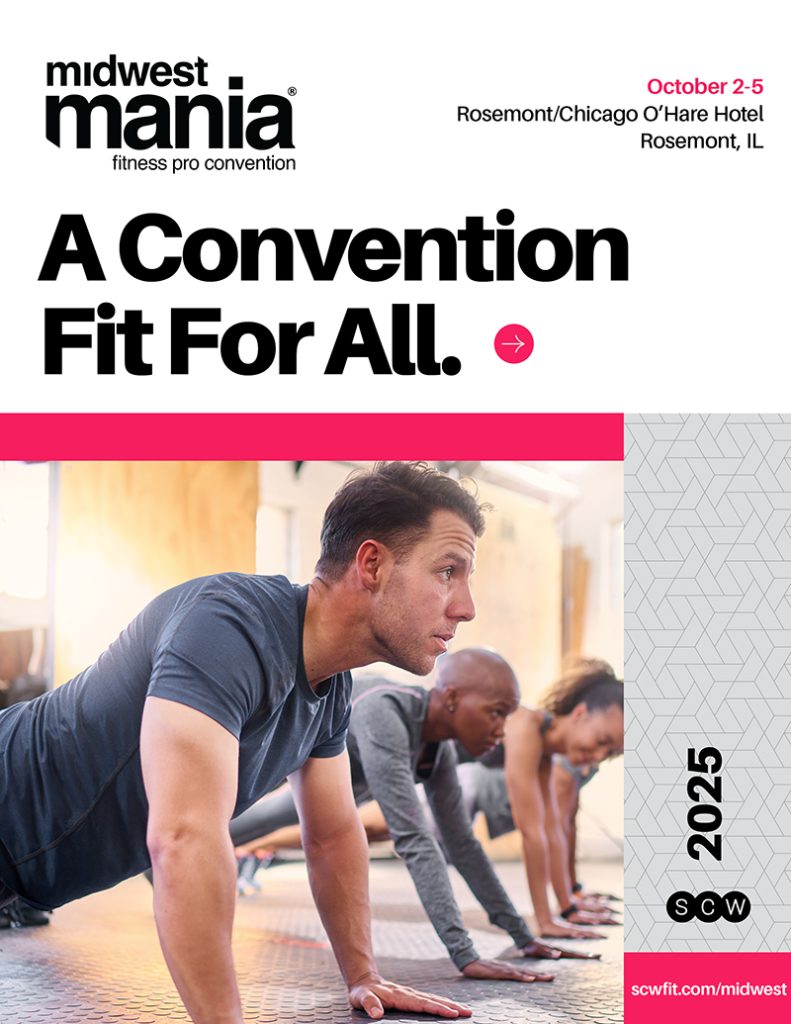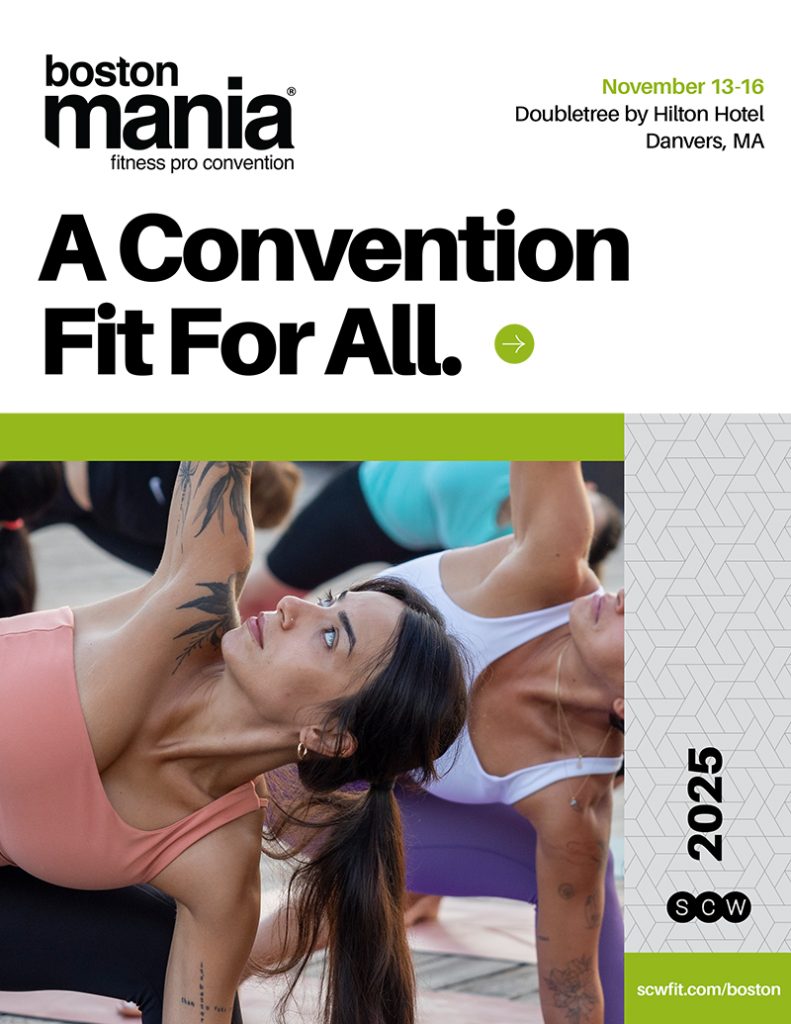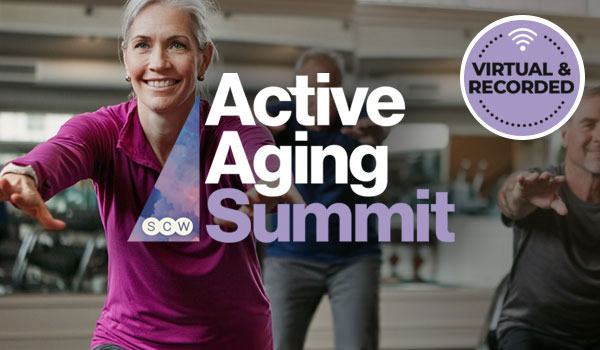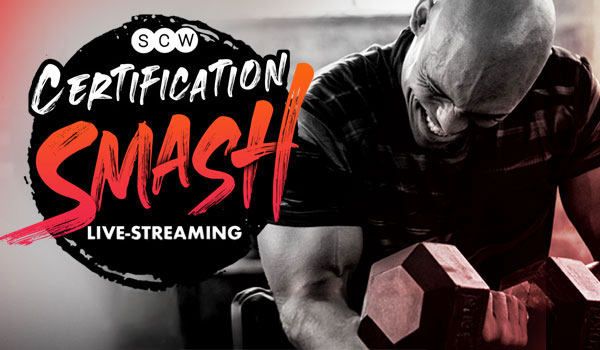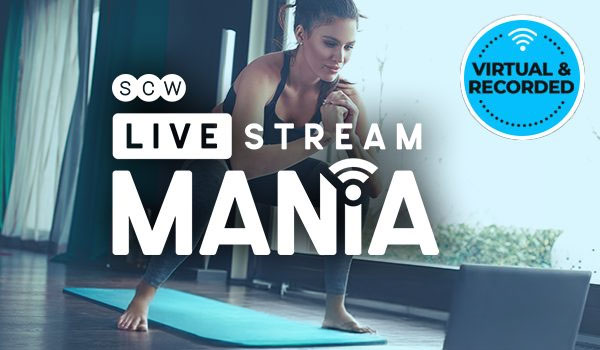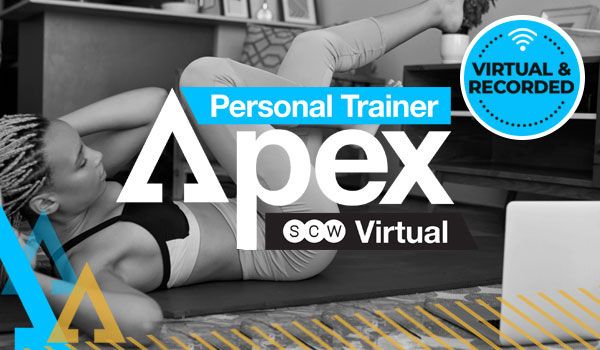
SCW Spotlite: Issue 77
- How to Make the Most of Your Mania® Experience: Your Guide That Lasts a Lifetime
- From Class to Community: Building a Sense of Belonging
- What Does “Advanced” Yoga Actually Mean
- From New Year to Year-Round: Strategies to Retain New Group Fitness Attendees
- Shaping the Future of Fitness
- SCW Fitness Launches the Anti-Obesity Medications & Fitness Programming Specialist Certification
- What’s Eating You? The Science of “Comfort Food” & Stress-Eating
- Looking to Hire? SCW Can Help!
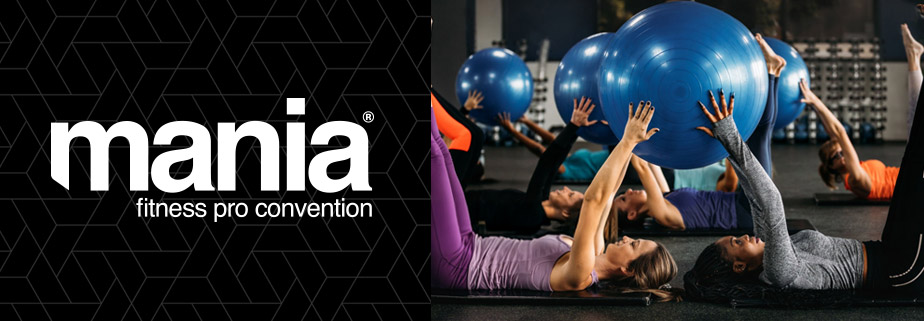
How to Make the Most of Your Mania® Experience: Your Guide That Lasts a Lifetime
by Sara Kooperman, JD
Attending a Mania® convention isn’t just about completing a list of fitness sessions — it’s about immersing yourself in a world of knowledge, growth, and connection. With over 160 sessions to choose from, including everything from hands-on choreography workshops to cutting-edge lectures on exercise science, nutrition, and business strategies, Mania® offers a unique opportunity to learn, connect, and grow as a fitness professional. Whether you’re a first-timer or a seasoned attendee, here are some top strategies to ensure you leave with more than just a list of notes — but an experience that lasts a lifetime.
- Plan Your Sessions Around Your Goals
One of the first challenges at any large conference is deciding which sessions to attend, especially with so many options available. At Mania®, the variety is vast — physical sessions with choreography, in-depth movement techniques, as well as business-focused lectures. To get the most out of the event, start by aligning your session choices with your immediate goals.
If you’re looking to expand your skill set, focus on sessions that teach new moves or programming techniques. If your focus is business growth, prioritize the sessions that cover marketing, revenue generation, and member engagement strategies. To get the best of both worlds, blend sessions that align with your current needs while leaving room for discovery. Sometimes, the best sessions are the ones you didn’t plan for, so be flexible enough to explore new topics that might spark your curiosity once you’re at the event.
- Prepare for Each Session Like It’s a Master Class
To get the most out of each session, preparation is key. It’s not just about showing up — it’s about engaging with the content at a deeper level. Almost every Mania® session offers downloadable outlines available a few weeks before the event, from session handouts to speaker slides. Familiarizing yourself with these resources before the event can help you better engage with the material during the session.
Another way to prepare is to enter each session with a specific goal in mind. Ask yourself: How can this session help me in my practice? What’s the one key takeaway I want from this lecture or workshop? Setting a purpose for each session ensures that you leave with actionable insights. Also, don’t forget to sit near the front! This encourages engagement and allows you to ask questions, making the session more interactive and impactful.
- Maximize Engagement During Sessions
Being present physically is one thing, but to truly benefit from a Mania® session, you need to engage mentally and emotionally. As both a presenter and your fellow attendees, I can tell within minutes who is actively involved in the session and who is just going through the motions. Your body language, eye contact, and attentiveness will not only help you absorb the material but also signal to the presenter that you’re engaged and interested.
Focus on capturing key takeaways rather than trying to write down every word. Selectively take a short video of particularly inventive moves or note down ideas that resonate with you as something you can bring back to your clients. And don’t be afraid to ask thoughtful questions during Q&A — this interaction deepens your understanding and makes the session more enriching for everyone involved. Asking questions also opens doors for future conversations with the presenter and fellow attendees, expanding your learning beyond the session itself.
- Reflect, Revisit, and Discuss What You’ve Learned
Once a session ends, don’t let the insights slip away. A few minutes of reflection immediately after the session can reinforce key concepts and help you identify action steps. Review your notes and highlight the most important points. Recheck your videos or photos. If you’re attending with friends, take a moment to debrief and share what you’ve learned. Often, I have seen teachers in the hallways videoing particular moves. Sometimes written notes just don’t do it!
And …. take home the videos SCW records during almost every session. Hotels and convention centers do not have the bandwidth to stream quality live videos. This is why no other event provides videos or sessions – it is expensive, time-consuming, and difficult to manage. But SCW Fitness makes this happen. SCW uses state-of-the-art, high-end cameras, takes the time (and expense) to render the videos, and uploads to an easy-to-use platform. Take advantage of these recordings. Watch them with a friend! (But shhh, don’t tell our SCW video team that this is allowed or that I recommended this!) Share and plan with another instructor to figure out what would work in your home personal training sessions and GX classes and use it! These take-aways are what MANIA is all about! Leaving with value.
Even if you’re flying solo, try to connect with other attendees onsite and share insights. Networking with like-minded professionals allows you to discuss ideas in real time and can lead to collaborative projects down the line. Plus, the more you talk about what you’ve learned, the more likely you are to turn those insights into actionable changes in your classes and sessions.
- Turn Knowledge into Action: Create Your Follow-Up Plan
The true value of Mania® doesn’t end when the event is over. To ensure you apply the knowledge you’ve gained, create a post-event follow-up plan. Review your notes and prioritize the changes you want to implement at your fitness facility or within personal practice. Whether it’s a new program idea or a business strategy, set specific goals for how you’ll bring these insights to life.
For example, if you learned new choreography, plan out when you’ll introduce it into your classes. If a business lecture sparked ideas for increasing member retention, make a strategy to apply those ideas within the next month. The key is to take concrete steps that ensure your learning has a lasting impact.
- Stay Connected After the Event
Learning doesn’t stop when the event ends. Many presenters at Mania® offer supplementary resources such as webinars, videos, and continued access to their materials. Take advantage of these opportunities to keep learning long after you’ve left the conference. Remember that event discounts are real! Take advantage of these.
Reach out to presenters with follow-up questions or for further clarification — many are more than happy to engage post-event, especially if you’re looking to implement their strategies. Connecting on LinkedIn or other social media platforms is another great way to stay updated on the latest trends and resources in your area of interest.
Additionally, networking with fellow attendees can lead to ongoing conversations and new professional relationships. You never know where a simple Instagram friend, follow-up email, or LinkedIn connection might lead. Building these relationships allows you to keep the learning going and opens doors for future collaborations or opportunities.
- Make the Most of Networking and Social Events
While the sessions are certainly the highlight of any conference, some of the most valuable moments often happen outside the classrooms and lecture halls. Don’t underestimate the power of networking in casual settings, like exhibitor halls, hotel restaurants, and elevators. Find out what presenters are “the best” and change your schedule. It is easy at a Mania, just check your schedule and change. These informal moments allow you to connect with others in the fitness community and build relationships that can last for years.
Take the time to visit exhibitors, and chat with other attendees during breaks. These conversations often lead to new ideas, insights, and business opportunities. Plus, you never know when you might meet someone who shares your passion or goals — and they could become your next collaborator, mentor, or business partner.
By following these tips, you’ll be able to make the most of your Mania® experience, ensuring that you not only leave with new knowledge but also with a network of like-minded professionals, new skills, and actionable strategies that will continue to benefit you long after the event ends.
So, what are you waiting for? Dive in, engage fully, and leave with an experience that will last a lifetime!

About the Author: Sara Kooperman, JD
Sara Kooperman, JD, CEO of SCW Fitness Education, WATERinMOTION®, and S.E.A.T. Fitness, Founder of the Mania® Convention, sits on the canfitpro Advisory Panel and the Gold’s Gym Think Tank and was a founding board member for the Women In Fitness Association (WIFA). Recently nominated for the IDEA Fitness Leader of the Year Award, Kooperman won the Most Innovating Fitness Pro by FIT-C (Fitness Industry Technology Council). Sara is the best-selling author of FIT FOR BUSINESS, an inductee into the National Fitness Hall of Fame, an Illinois State Businesswoman of the Year, an esteemed panelist for multiple Webinars & Podcasts, and sits on the ACSM Communication & Public Information Committee.
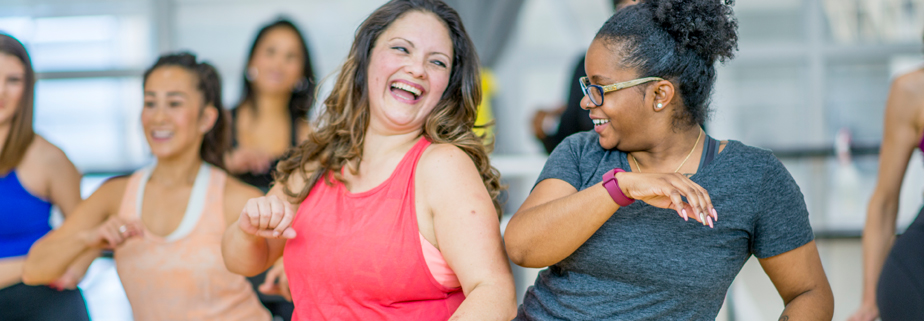
From Class to Community: Building a Sense of Belonging
By Renette Schmidtke
Community – a feeling of fellowship with others as a result of sharing common attitudes, interests, and goals.
Everyone wants to belong. To be a part of something. A place to fit in. Is your class “that” place?
We’re talking about going beyond the workout. Creating a sense of belonging, accountability, and connection among members. Achieving fitness goals through consistently.
Are you building community?
8 Fresh Ideas for Building Community in your Class
- Get together outside of class – It is an easy way for members to build relationships and connections with each other. Social events outside of the gym create stronger relationships that go beyond the workout. When people see each other as more than just workout partners, they feel more comfortable and invested in each other’s success.
Suggestions:
- Meet up for a meal, coffee, or cooking class
- A group walk and talk,
- Charity walks or run
- Collaborate on a fun project – Members not only engage with each other, but they come together to work on a shared project and/or cause. It’s a win for everyone! This is great for fostering teamwork while also contributing to the community. Working on a charity or a class project brings out a sense of shared purpose that deepens the bond between participants.

Suggestions:
- Create a class cookbook
- Volunteer at an animal shelter
- Volunteer at a food bank
- Partner or Team workouts – Working as a team is an opportunity for communication, collaboration, and strategy to complete a workout together. Before the workout begins, have members introduce themselves so they know who they’re working with. Encourage team members to give high fives during the workout, which motivates each other to finish strong. Partner workouts, especially those that mix skill levels, create a supportive environment. The idea of teammates encouraging each other with high-fives or sharing strategies to complete a workout can elevate the class atmosphere and create a sense of camaraderie.
Suggestions:
- Partner Valentine’s HIIT (i.e., High Fives, Squats, Plank Clap)
- Team-based Chipper where each member contributes to the workout
- Team up members with different skill and fitness levels
- Host a Potluck – If your facility allows it, break bread and fellowship together after class. Food brings people together for their shared love of food on any occasion. It is a universal connector. After a good workout, sharing a healthy meal can make the experience even more enjoyable. Plus, it’s a great way to discover new recipes and cooking tips!
Suggestions:
- Holiday-themed (i.e., Christmas Cookie Exchange, Thanksgiving, etc.)
- Healthy recipe swap
- Monthly or Quarterly Member birthdays
- Recognize member birthdays – Everyone loves to be recognized and feel special on their birthday! Birthdays are personal milestones celebrated by all. It’s a simple gesture that can go a long way in making a member feel valued and special within the group.
Suggestions:
- Sing “Happy Birthday”
- Take a pic of the birthday group and post it on social media
- In class, play their favorite song or do their favorite move
- Ask fun non-fitness questions – Questions can spark laughter and meaningful conversation between members. They may also discover shared interests, which could develop into a new friendship. Breaking the ice with non-fitness questions can foster more personal connections. It allows members to see beyond the workout and discover common interests, which can help form lasting friendships.
Suggestions:
- What hobby would you pursue if you had unlimited time?
- What’s your favorite way to travel?
- What’s your favorite line from any movie?
- Create a fun class name – A fun, catchy name brings an identity to your class. It makes everyone feel they belong and have a sense of purpose. What a way to turn your class into something special. It makes everyone feel like they’re part of something with a specific vibe and culture. A hashtag can also help build a sense of online community and pride.
- Host a class vote to decide the name
- Base the name on your class format (i.e., HIIT Crew)
- Add a hashtag (i.e., #HIITCrew)
- Introduce new members to regulars – new members often feel intimidated coming to their first fitness class. Introducing newbies to class regulars creates an instant connection. Regulars feel a sense of ownership by helping newcomers, reinforcing their sense of belonging.
From the list, is there a particular idea that stands out to you, or one you’re ready to try with your class?
In 2025, beyond physical transformations, the emotional and social connections people build in your class can help them stick with their fitness journey longer and with more joy. This holistic approach—fostering community and belonging—will certainly lead to greater success for everyone involved.
Don’t wait, act and get started today.

About the Author: Renette Schmidtke
Renette Schmidtke, Group Fitness Manager in Dallas, holds a BS in Food Science Technology (Texas A&M) and an MEd in Health Education (UT Austin). She is an AFAA Certified Group Fitness Instructor, NCSF Personal Trainer, and Yoga Fit Level 1 certified, with additional certifications in Pilates, Kettlebell, and FMS Level 1. Passionate about empowering women in strength training, she leads Women on Weights to debunk weightlifting myths. A WBFF pro, she has competed in figure and physique competitions, triathlons, duathlons, cycling races, and adult track meets, earning medals in 100m, 200m, and relay events.

What Does “Advanced” Yoga Actually Mean?
by Lisa Greenbaum
First and foremost, advanced asana practice is NOT advanced Yoga but rather a more complex physical practice to challenge our strength, stamina, and ability to be still in mind and body.
With Yoga, the goal is Yoga itself. Hearing this might hurt our brain a little. Everything we do, from increasing our weight in strength training, pushing ourselves further and faster in our cardio, or excelling in competition in sport, is based on advancing our training. There is a clear destination or goal, and that’s what we strive for.
However, Yoga is a state of being. It is the moment that our mind is clear, that the continued cluttered thoughts (citta vritti) have dissolved, and we feel most connected to ourselves. That is the definition of Yoga provided to us by Patanjali, the ancient scholar and author of the Sutras of Patanjali, a revered book on Yoga philosophy. Ultimately, to become advanced in Yoga is the ability to hold the state of Yoga, citta vritti nirodaha, for longer durations.
We get there through continued practice of all 8 Limbs of Yoga:
Y amas – social ethics, how we interact with each other
amas – social ethics, how we interact with each other
Niyamas – personal ethics, how we treat ourselves
Asana – postures
Pranayama – breath work
Pratyahara – withdrawal of the senses
Dharana – concentration
Dyana – meditative mind (can’t be taught)
Samadhi – bliss, or unity consciousness
When we first start to practice Yoga, what one finds “advanced” or challenging is often quite different from someone else. I think of ex-dancers like me, where the flexibility of the postures came easily for me when I first started. I could do more of the extreme postures in my 20s than I can now, but unfortunately, I was also losing all of the powerful benefits that come from the mindfulness aspects of Yoga.
Certainly, I felt good mentally, as we always do after moving our bodies, but that usually ended within a few hours of rolling up my mat. Today, after studying Yoga and meditation for over 20+ years, my practice is more advanced than it was then, and I still feel like I have so far to go. As we step past what most consider Yoga, aka the poses, and more into the meditation aspects, this is where the real experience begins.
Yoga is not limited to the hour we spend working on our mat, but all the small moments of pause throughout the day. This is the real power of Yoga, when the mind is clear and we find the gap. When we can take in what is going on around us without an automatic reaction. When we can just be. Yoga is for everybody, and everybody should be practicing some element of Yoga every day. Taking time every day to be fully present and in tune with ourselves – that is all that Yoga is asking from us. It doesn’t have to be this big setup; we don’t need fancy clothes or props, and we most definitely don’t need to be able to touch our toes.
Especially for those of us who get stuck in the same hamster wheel of thought, or experience anxiety, we need to practice stillness within. If you have ever tried meditation and thought it was too difficult, that is the first step to understanding the great benefits a regular practice would bring. That being said, just like pushing ourselves a little extra during our weight training sessions, we should practice postures that challenge us. When we go through the same postures and sequences all the time, we start to get complacent in our practice. Where certain postures previously held our full attention, sometimes we find our mind drifting off to other things outside the room. The challenge of these postures helps us stay present and focused. Remember, we call this Yoga practice because asana and the meditative mind require practice. The more worried we are about achieving the poses, the further away they become. We should always be approaching asana with curiosity and perhaps even a sense of playfulness.
We need to consider what the purpose of bringing these poses into our practice are for. For those who are quite athletic or perhaps have been practicing for a long time, the challenge of these poses is needed – and NOT just from a physical standpoint. We need to remember what it feels like to be “new” again, to experience frustration or disappointment while struggling with a posture. To go through the process required to get past this, to quiet the mental modifications, the negative voice in our head to come back to what the experience of Yoga is. If this isn’t for joy, then simply what is the point?
Every time you practice asana, please keep the following in mind:
Our breath should always be our number one indicator of how we are doing in each and every pose. If our breath is labored or short, we are in too deep. Likewise, if we are in an active pose and our breath is too easy, we can probably go deeper. Always refer to your breath inside the pose and through your transitions.
When the bandhas (locks) are engaged, the rest of the body will find its way. The primary bandhas refer to moolabandha, or pelvic floor muscles, uddiyana bandha, or core connection, and jalandhara bandha, or throat lock and lengthening through the back of our neck.
From the Sutras of Patanjali (one of the main Yoga philosophy texts) 2:46 “Sthira Sukham Asanam” or “Asana is a steady, comfortable posture.” (Swami Satchidananda). Within every pose and through every transition this should always be considered.
Remember, the goal of Yoga is Yoga itself. A state of being. If you are pursuing the dream of becoming an “Advanced Yogi” through postures only, you will be like a dog chasing its own tail, simply going around and around until you are tired and dizzy (or injured). Rather, think about advancing your studies and committing to a regular daily practice. This isn’t something to master and then move on, but a lifelong journey of ebbs and flows. What you achieve is peace and the ability to come back more easily to that peaceful state. What a powerful gift this practice is.
Lastly, visit my website at Sangha Yoga Collective. Find out how sangha=community, explore our memberships, and how you can become 200 or 300 hour YTT certified.

About the Author: Lisa Greenbaum
Lisa is the founder of Sangha Yoga Collective, a certified Trauma-Informed Yoga Therapist, E-RYT 500 Yoga Teacher, international presenter, and author. With over 20 years in the Fitness and Wellness industry, she has been recognized for her contributions, including multiple awards like Presenter of the Year. As a Global Ambassador for the Women in Fitness Association (WIFA) and a Top 100 Health and Fitness Influencer in Canada (2017-2021), Lisa is dedicated to fostering authentic, inspirational experiences.
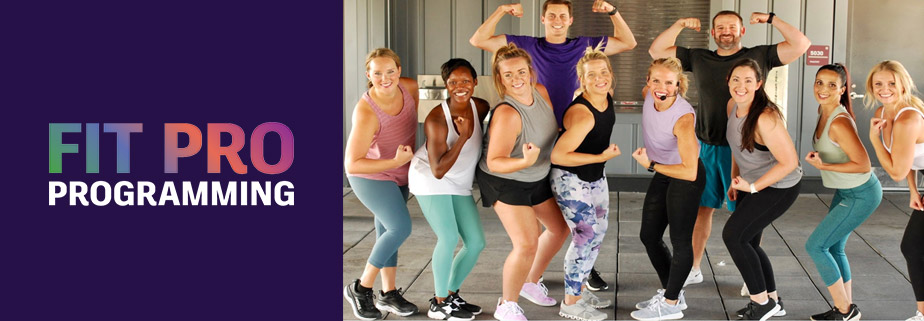
From New Year to Year-Round: Strategies to Retain New Group Fitness Attendees
By FIT PRO PROGRAMMING
The New Year often brings an influx of new participants to group fitness classes, eager to kickstart their fitness goals. As a fitness instructor, creating a welcoming and supportive environment is key to ensuring these newcomers feel successful and inspired to return. Whether you’re teaching Barre Above, Pumped Up Strength, Balletone, Human Reformer, Swerve Cycling, or Ever Flexed, these strategies can help:
- Simplify Choreography
While seasoned participants may love a challenge, keeping your choreography simple and easy to follow (that doesn’t mean it can’t be challenging physically) during this time can make a huge difference for new attendees. Use basic movements and clear cues to build their confidence. Once they feel more comfortable, you can gradually increase the complexity of your choreography in future classes.
- Provide Multiple Options for Success
Not all participants come in with the same fitness level or experience. Offer a variety of options for each movement instead of labeling them as modifications or levels. Present these options as equally effective choices to help participants feel successful no matter which one they select. Encourage everyone to pick the version that works best for them, and celebrate their effort and progress, emphasizing that all choices are valid and valuable.
- Arrive Early to Greet Participants
Arriving at least 15 minutes before class gives you time to welcome participants personally, especially those who are new. A friendly smile and quick introduction can ease nerves and help new attendees feel more connected to you and the class.
- Set Newcomers Up for Success
Guide newcomers to a spot where they can easily see you and have access to all the necessary equipment. This small act prevents confusion and ensures they feel prepared. Avoid placing them at the very front or back if possible—a middle spot often provides the best visibility without feeling too exposed. For example, in Human Reformer, ensure they have the correct length of Flex Kords and know how to set them up correctly.
- Encourage Social Connections
Program moments during class for participants to engage with each other, such as pairing up for partner exercises or sharing a quick high-five during a break. Building a sense of community can make new attendees feel more included and excited to return. Additionally, take a moment to introduce newcomers to some of your friendly and talkative regulars. This simple gesture can help them feel like a part of the group and avoid the discomfort of being left out of class conversations.
- Use Positive Reinforcement
Praise participants for their effort and progress, especially new attendees who might be feeling self-conscious. A simple one-on-one “Great job” or “You’re doing awesome” can go a long way in boosting their confidence.
- Create a Welcoming Environment
Start the class with a warm introduction that includes a quick overview of what to expect. Let everyone know it’s okay to take breaks or modify as needed. This sets a non-intimidating tone and reassures participants.
- Check In After Class
Take a few minutes after class to thank participants for coming and ask how they felt about the workout. This one-on-one interaction can make newcomers feel valued and gives you insight into how to better support them. This is also a great time to answer any individual questions they might have and invite them to join you for another class.
- Celebrate Small Wins
Take time to recognize individual achievements, whether it’s completing the entire class, trying a new movement, or making progress on a skill. Highlighting these small wins reinforces a positive experience and motivates participants to keep coming back. Congratulating them personally also helps them feel seen and valued as part of the class community, building a stronger connection with your group.
- Create a Follow-Up Plan
Encourage new participants to return by sharing your class schedule or inviting them to join a fitness challenge or membership program. A personalized touch, like a quick email or social media message thanking them for attending, can strengthen the connection and increase the likelihood of them becoming regulars.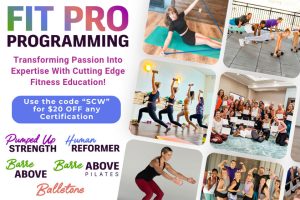
By implementing these strategies in your Barre Above, Pumped Up Strength, Balletone, Human Reformer, Swerve Cycling, or Ever Flexed classes, you’ll create an environment where new participants feel welcome, supported, and excited to embark on their fitness journey. As their confidence grows, so will their commitment—turning them into loyal members of your fitness community!
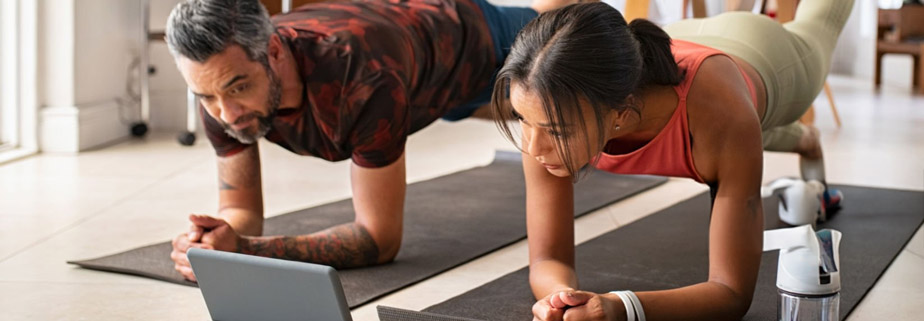
Shaping the Future of Fitness
Over the past few months, SCW Fitness Education has continued to set the standard in fitness education with a powerful lineup of events including Certification Smash, DC Mania®, CA Mania®, and most recently, the Active Aging Summit. Thank you to everyone who joined us for this incredible virtual event focused on training, supporting, and inspiring the 50+ population.
Whether in person or online, these events have empowered thousands of FitPros with advanced training, the latest research, and nationally recognized certifications—giving them the tools to transform lives and grow their careers.
Looking Ahead: Your 2025 SCW Event Calendar
As we move forward, SCW is offering even more opportunities for connection, education, and inspiration—both live and virtual. Don’t miss your chance to be part of what’s next!
![]() Upcoming Events Include:
Upcoming Events Include:
- Active Aging Summit (Recordings Available Now!)
activeagingsummit.com - FL MANIA® | May 1–4
scwfit.com/florida
- Atlanta MANIA® | July 24–27
scwfit.com/atlanta - Dallas MANIA® | August 21–24
scwfit.com/dallas - Live Stream MANIA® | September 13–14
livestreammania.com - Midwest MANIA® | October 2–5
scwfit.com/midwest - Boston MANIA® | November 13–16
scwfit.com/boston
From business strategies and group fitness to active aging and personal training, these conventions deliver hands-on education led by renowned experts like Melissa Layne, MEd, Ruston Webb, MS, Ann Gilbert, Gail Bannister-Munn, and Patrick Mummy, creator of the ground-breaking AlignSmart(formerly Symmetry) posture alignment system.
The Power Behind the Experience: SCW’s Stream Team
Our incredible SCW Stream Team continues to ensure each event—live or virtual—is seamless, inclusive, and accessible. This dedicated group of tech professionals, bookkeepers, and bilingual support staff go above and beyond to provide a smooth and supportive experience for every participant.
Certifications & Career Support
SCW doesn’t just offer over 40 live and online certifications across disciplines—we’re committed to supporting your career beyond the classroom. Our SCW Job Board (scwfit.com/JOBS) connects certified professionals with employers across the country, making job placement easier and more accessible than ever.
Join Us—We’re Just Getting Started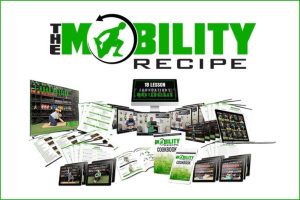
Thank you again to everyone who participated in the Active Aging Summit, Certification Smash, DC Mania®, and CA Mania®. Your commitment to learning and leading inspires everything we do.
We look forward to seeing you at Florida Mania®, Atlanta Mania®, or one of our other exciting events in 2025. Let’s keep building the future of fitness—together!
![]() Learn more at www.scwfit.com/MANIA
Learn more at www.scwfit.com/MANIA

SCW Fitness Launches the Anti-Obesity Medications & Fitness Programming Specialist Certification
The global obesity epidemic is a growing concern, affecting millions of individuals worldwide. In response to this urgent health crisis, new strategies are emerging to combat obesity, including the use of anti-obesity medications, like GLP-1s (glucagon-like peptide-1 receptor agonists). In tandem with these medical advancements, fitness and wellness programs are evolving to complement medical treatments, creating a more holistic approach to weight management
Anti-obesity medications (AOMs) are prescription drugs designed to assist with weight loss by regulating appetite, metabolism, and fat absorption. They are typically recommended for individuals with a BMI of 27 or higher with related health conditions such as type 2 diabetes or hypertension. Common examples include GLP-1 receptor agonists like semaglutide (Ozempic, Wegovy) and other various medications, which reduce appetite, slow digestion, and prevent fat absorption. They also affect hunger signals and target brain pathways to reduce cravings. These medications work best when combined with lifestyle changes, including healthy eating and regular exercise.
The SCW Fitness Anti-Obesity Medications & Fitness Programming Specialist certification is a groundbreaking course designed to equip fitness professionals with the knowledge and skills needed to integrate anti-obesity medications with personalized fitness and wellness strategies. This certification offers a comprehensive understanding of how these medications work, their impact on metabolic health, and how fitness programs can be tailored to maximize their effectiveness, and will be launching soon.
A Growing Need for Holistic Weight Management Solutions

Obesity is a complex condition that affects not just physical health but mental and emotional well-being. The rise in obesity rates has led to an increase in demand for effective weight management solutions that address all aspects of the issue, from medical interventions to exercise and nutrition. Anti-obesity medications, such as GLP-1 receptor agonists, have been shown to have a profound impact on weight loss and metabolic function, however, medication alone is often not enough to produce lasting results.
This is where fitness professionals come in. By combining medical interventions with tailored fitness programming, nutrition guidance, and behavioral coaching, fitness professionals can help clients achieve long-term success in their weight management journeys. SCW Fitness’ new certification teaches the necessary skills to become a trusted expert in this integrated approach, providing a unique opportunity for professionals in the fitness and wellness industry.
The Role of Anti-Obesity Medications in Weight Management
Anti-obesity medications, particularly GLP-1 receptor agonists like semaglutide, have revolutionized the way obesity is treated. These medications mimic the action of the GLP-1 hormone, which plays a key role in regulating appetite and glucose metabolism. By enhancing satiety, reducing appetite, and improving insulin sensitivity, GLP-1 medications can help individuals lose weight and improve their metabolic health.
The SCW Fitness certification dives into the development and evolution of these medications, from their early use to current advancements. Participants will gain a deep understanding of the mechanisms behind GLP-1 drugs, their FDA approvals, ongoing research, and the expected health outcomes for clients. With this knowledge, fitness professionals will be able to create more effective, individualized fitness plans that align with the physiological changes induced by these medications.
Research and Results on Anti-Obesity Medications
The certification also explores the latest research and clinical trial results related to anti-obesity medications. Key studies, such as the STEP, SURMOUNT, and SCALE trials, have demonstrated the effectiveness of GLP-1 medications in helping individuals lose significant amounts of weight, and reduce the risk of type 2 diabetes.
However, fitness professionals need to understand the potential side effects and safety considerations associated with these medications. The certification incorporates common side effects, including nausea and gastrointestinal issues, and provides guidance on how to address these challenges while maintaining a safe and supportive fitness environment.
In addition, long-term efficacy and limitations are discussed, helping fitness professionals manage expectations and better support clients throughout their weight loss journeys. By staying up to date with the latest research, fitness professionals can ensure they are providing the most accurate and effective guidance for their clients.
Tailoring Fitness Programming for Clients on Anti-Obesity Medications
Integrating fitness into the weight management process is essential, especially when clients are using anti-obesity medications. The SCW Fitness certification emphasizes the role of physical activity in enhancing the effects of these medications. Fitness programs are not just about weight loss; they are also designed to improve metabolic health, boost mood, and increase overall well-being.
The certification outlines general fitness guidelines, such as the FITT principle (Frequency, Intensity, Time, Type), which can be applied to clients on anti-obesity medications. Special considerations for GLP-1 clients, including managing potential side effects like nausea, are also discussed. Fitness professionals will learn how to adapt exercise routines to accommodate clients who may be new to physical activity or who face additional challenges due to their weight.
From beginner to advanced fitness levels, the certification provides templates for fitness programs that can be adapted to meet the unique needs of each client. Group and small-group exercise protocols are also included, allowing trainers to cater to a broader audience and maximize their impact.
Nutrition and Behavioral Coaching for Long-Term Success
Nutrition plays a critical role in weight management, and the SCW Fitness certification offers extensive guidance on how to incorporate nutritional recommendations into fitness programs. Participants will learn about macronutrient guidelines, meal timing, portion control, and the importance of hydration. More importantly, the course provides strategies for building sustainable eating habits, which are crucial for long-term success.
Behavioral coaching is another key component of the certification. Fitness professionals are taught how to build trust, encourage accountability, and help clients overcome psychological barriers, such as emotional eating. Motivating clients and helping them set realistic goals are essential for long-term adherence to a weight management plan. This certification equips trainers with tools and resources to guide clients through these challenges, empowering them to make lasting changes in their lives.
Ethical Considerations and Professional Standards
The SCW Fitness certification also places a strong emphasis on the ethical and professional standards required when working with clients on anti-obesity medications. Fitness professionals must operate within their scope of practice, ensuring that they respect client privacy and confidentiality while promoting a client-centric approach to care. The course covers the importance of collaboration with healthcare providers, obtaining waivers of liability, and understanding the legal and ethical considerations involved in delivering fitness programming alongside medical treatments.
By adhering to ethical standards and maintaining a professional relationship with clients, fitness professionals can foster a supportive and trusting environment that leads to lasting results.
Case Studies and Practical Applications
To ensure that the concepts taught in the certification are applicable in real-world settings, the course includes several case studies. These case studies illustrate how to design and implement fitness programs for a range of clients, from beginners to advanced fitness enthusiasts, all while incorporating the use of anti-obesity medications. By learning from these practical examples, fitness professionals can better understand how to apply their knowledge in diverse scenarios and address common challenges that arise in practice. 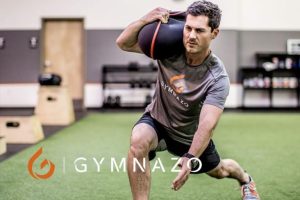
Future Opportunities
The SCW Fitness Anti-Obesity Medications & Fitness Programming Specialist certification provides fitness professionals with a comprehensive toolkit for transforming lives through an integrated approach to weight management. With a focus on the latest research, fitness programming, nutrition, behavioral coaching, and ethical considerations, this certification empowers trainers to become experts in holistic weight management. Students can earn CEUs from SCW (7.0), ACE (0.7), and NASM (0.7).
As the field of obesity treatment continues to evolve, so too will the role of fitness professionals in supporting clients on their journeys. By earning this certification, trainers not only enhance their expertise but also open doors to new career opportunities in the growing field of anti-obesity treatments and fitness.
For fitness professionals looking to stay ahead of the curve and make a significant impact in the fight against obesity, the SCW Fitness Anti-Obesity Medications & Fitness Programming Specialist certification is an invaluable resource.

What’s Eating You? The Science of “Comfort Food” & Stress-Eating?
By Tad Taggart, RDN
“I am enjoying a relationship with two men simultaneously. The first is called Ben, the other, Jerry. Number of current boyfriends: zero.”
— Bridget Jones, Bridget Jones: The Edge of Reason (2004 movie)
In the Friends episode “The One with the Thumb”, Monica dates a man named Alan. As the rest of the gang comes to know Alan, they become even more enamored with Alan than Monica. When Monica breaks up with him, the whole crew takes it pretty hard. At one point, she walks in to find them collectively drowning their sorrows in tubs of ice cream.
Why is it that this common trope in television and movies seems to persist? We often see the heartbroken individual turn to a dessert-like food for solace. Many people will see this and at least understand what’s being conveyed, if not have a level of empathy for having a similar experience. We seem tied to this recurring imagery because it resonates with us. It feels familiar. Many people are familiar with and understand the concept of “comfort food”, but did you know that there’s ancient biological wisdom hidden beneath this comedic messaging? For generations, fables and mythical tales have been often told to convey moral lessons or wisdom. In our current age, television, and film are our most common vehicle of storytelling, and it’s possible that television could be passing along innate, ancient wisdom.
For most, the common reaction to stressful events is either a noticeable increase or decrease in appetite. But why is that? Why would appetite change at all in response to stress, and why is it different in different people? And with that, why is it we would rather reach for something like ice cream than celery?
Like many of the baffling phenomena related to food and eating, we have to start by looking at the brain. Specifically, we are concerned with the motivational circuit, where dopamine is released after positive experiences to serve as the ‘rewards system’. This motivational circuit overlaps with the limbic system, which is the part of our brain responsible for emotions, reactions to stressors, and responses that are critical to maintaining homeostasis (keeping us safe and functioning). You could refer to the limbic system as our “caveman brain” or “survival brain” because it only knows how to respond to emotions and try to keep us alive.
In addition to the limbic system, we need to be familiar with the prefrontal cortex (PFC). The PFC is responsible for what you might call “higher-level thinking”. This is the region of the brain that is typically responsible for executive functioning, planning, and control of impulses, desires, and cravings. You might call this part of our brain, the “mature adult” brain. During times of high stress, our “mature adult” brain (PFC) is overtaken by the “survival brain” (limbic system). With the limbic system in the driver’s seat, we are more prone to “automatic” behaviors done for survival. In other words, our brain only knows that it is stressed and needs to survive. Back in the “caveman days” where food was scarce, seeking out food in response to stress meant avoiding starvation. This reaction of seeking higher fat and/or carb foods in response to stress is actually a brilliant survival mechanism. In times of high stress, our ancestors didn’t have time to sit back and contemplate their five-year plan. High stress meant danger. Danger meant a need for immediate action. Eat to avoid starvation or run to avoid predators.
To support this survival instinct, our body has established metabolic and hormonal reactions to further help endure stressors. In a normal stress-response, cortisol is acutely elevated, causing metabolic changes (like increased blood glucose mobilization, blood flow redirected to the muscles/heart/muscles, and increased heart rate) designed to prepare us for “fight or flight”. As these changes occur, our body decreases the priority of digestion and appetite. Historically, sitting down to eat never seemed like a top priority when running away from a hungry tiger.
These responses are all what we expect and actually want in response to normal, short-term stress. This is what helps us perform better on the test, in the big meeting, or during our athletic competitions. Where we run into problems is when that stress doesn’t come back down.
Chronic stress can contribute to a host of unsavory health issues. In the context of stress eating, we are concerned with chronic stress causing dysregulation of the hypothalamic-pituitary-adrenal (HPA) axis. This dysregulation can have consequences for our appetite regulation. In general, people already under chronic stress are more prone to experience greater appetite and cravings in response to additional, acute stressors. In these scenarios, research has also shown that people show a greater preference for foods higher in carbohydrates and/or fats.
But what happens when, or if, you choose to follow these cravings? What happens, physiologically, when you reach for that pint of ice cream your body beckons for after a brutal day? Interestingly, choosing to abide by these cravings may help dampen the stress response. It’s been shown that insulin action helps to reduce cortisol. Insulin is released in response to eating foods, particularly those with carbohydrates. The greater the carb intake, the greater the insulin response. The greater the insulin increase, the greater the suppression in cortisol. In other words, that sweet treat could actually be just the medicine your body needs to take the edge off your stress. If anything, this speaks to the innate wisdom your body holds related to food and health.
What happens if you resist the ice cream? What if you are committed to a particular diet style and have decided that whatever your body is craving doesn’t fit in the plan? This is called “restrained eating,” and research has shown that this perspective only serves to further raise cortisol levels during a stress response and, ultimately, contributes to more frequent and/or intense cravings in response to future stressors.
By fighting these cravings, you are fighting your biology. You’re opposing your survival instincts. The body doesn’t understand the difference between a rough day at work and being chased by a tiger. In the same way, the body doesn’t understand the difference between choosing not to eat something and simply starving from a lack of available food. To the body, stress is stress. Hunger is hunger. Following a stressful event, your limbic system (“survival brain”) takes over, causing you to be more ‘reactive’ to your stress and emotions. By resisting the drive and urges of “survival brain,” cortisol stays high, the limbic system stays in the driver seat longer, and you feel stressed out longer.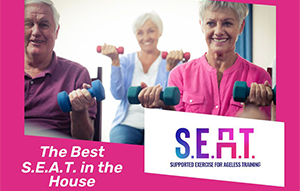
So, what do I suggest? Stop fighting your biology. Eat the ice cream. Help your cortisol return to baseline more quickly, which will let the limbic system take the back seat and put the prefrontal cortex back in control. Once you’re not in ‘max stress’ mode anymore, you can address the thing that stressed you out in the first place and try to keep the stress from becoming a chronic issue.
Remember, stress isn’t a problem. Chronic stress is. In the same way, stress-eating isn’t a problem. Chronic stress-eating is. Food can’t fix your problems. Don’t allow it to be the sole way you handle stress. That being said, removing the stress from stress-eating will allow you to critically appraise your stress. Using the “mature adult” brain (PFC), you’ll be able to problem-solve solutions to your stressor and explore alternative ways to cope with stress that don’t always depend on food.
Sources:
Yau, Y. H., & Potenza, M. N. (2013). Stress and eating behaviors. Minerva endocrinologica, 38(3), 255–267.

About the Author: Tad Taggart, RDN
Tad is the lead registered dietitian at Western Racquet & Fitness Club in Green Bay, WI. There, he founded the Nutrition Services Department as well as GameChangers at Western, an outpatient nutrition counseling program for active individuals and athletes struggling with eating disorders. In addition, Tad is one of the master-level trainers on staff, certified through the ACSM, and he leads a variety of group fitness modalities, including strength, HIIT, and boxing. When training and teaching group fitness, Tad encourages clients to focus on the joy rooted in movement. His passions lie in teaching people how to pursue holistic, sustainable nutrition & fitness goals through an intuitive eating and HAES lens.
Looking for a New Job? SCW Can Help!
Facilities need you! Whether it’s Teachers, Trainers, Directors, or Managers, SCW’s new FREE JOB BOARD is supporting the industry’s need for qualified fitness pros.
We post openings in all three of our monthly e-newsletters: Spotlite, Health & Fitness Business News, and Tidal Waves which are emailed out to tens of thousands of fitness professionals teaching and training in all formats along with managers and directors at all fitness facilities: big box, gyms, boutique, studios, not for profits and independent centers.
Share this newsletter
 We’re always looking for great content highlighting the newest things in the world of fitness. Please submit your article directly to editor@scwfit.com for immediate consideration!
We’re always looking for great content highlighting the newest things in the world of fitness. Please submit your article directly to editor@scwfit.com for immediate consideration! Spotlite, April 9, 2025
Spotlite, January 5, 2025
Spotlite, November 11, 2024
Spotlite, September 27, 2024
Spotlite, August 31, 2024
Spotlite, July 26, 2024
Spotlite, June 22, 2024
Spotlite, May 23, 2024
Spotlite, April 26, 2024
Spotlite, March 22, 2024
Spotlite, February 19, 2024
Spotlite, January 20, 2024
Spotlite, December 21, 2023
Spotlite, November 18, 2023
Spotlite, October 22, 2023
Spotlite, September 21, 2023
Spotlite, August 19, 2023
Spotlite, July 19, 2023
Spotlite, June 19, 2023
Spotlite, May 18, 2023
Spotlite, April 21, 2023
Spotlite, March 28, 2023
Spotlite, February 18, 2023
Spotlite, January 21, 2023
Spotlite, December 16, 2022
Spotlite, November 19, 2022
Spotlite, October 22, 2022
Spotlite, September 24, 2022
Spotlite, August 23, 2022
Spotlite, July 22, 2022
Spotlite, June 20, 2022
Spotlite, May 18, 2022
Spotlite, April 20, 2022
Spotlite, March 25, 2022
Spotlite, February 17, 2022
Spotlite, January 14, 2022
Spotlite, December 17, 2021
Spotlite, November 18, 2021
Spotlite, October 25, 2021
Spotlite, September 16, 2021
Spotlite, August 9, 2021
Spotlite, July 10, 2021
Spotlite, June 8, 2021
Spotlite, May 14, 2021
Spotlite, April 30, 2021
Spotlite, March 30, 2021
Spotlite, February 23, 2021
Spotlite, January 20, 2021
Hyatt Regency Dulles
Herndon, VA
Hyatt Regency SF Airport
Burlingame, CA
Caribe Royale Orlando
Orlando, FL
May 1-4, 2025
May 2026
Grand Hyatt Atlanta Buckhead
Atlanta, GA
July 24-27, 2025
July 2026
Westin Galleria Dallas
Dallas, TX
August 21-24, 2025
August 28-30 2026
Rosemont Chicago O’Hare
Rosemont, IL
Oct. 2-5, 2025
Oct. 2-4 2026
Doubletree by Hilton
Danvers, MA
Nov. 13-16, 2025
Nov. 13-15, 2026

